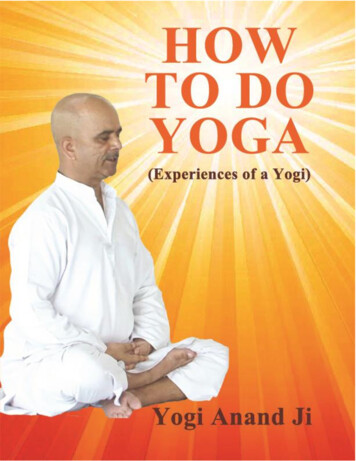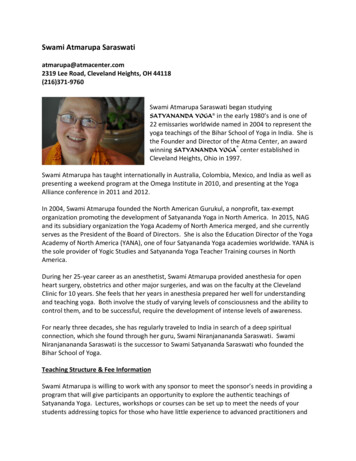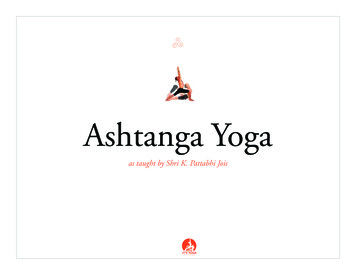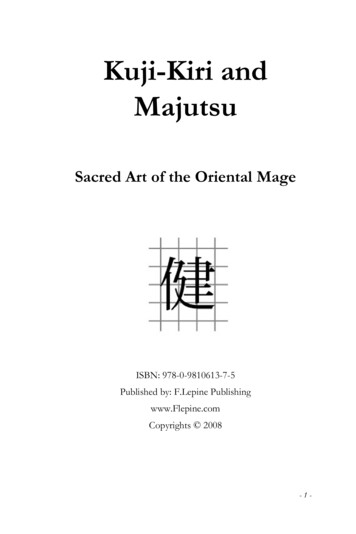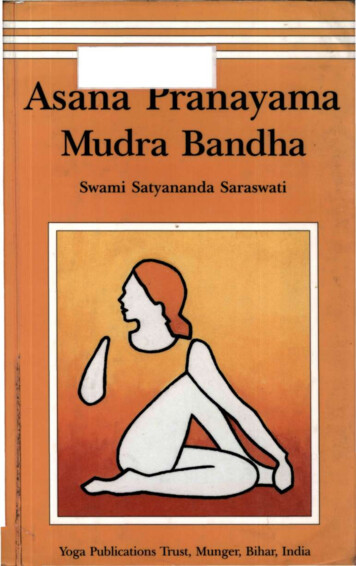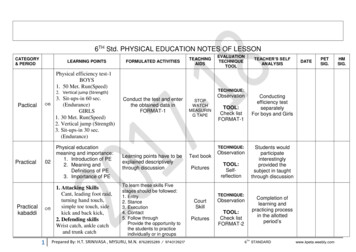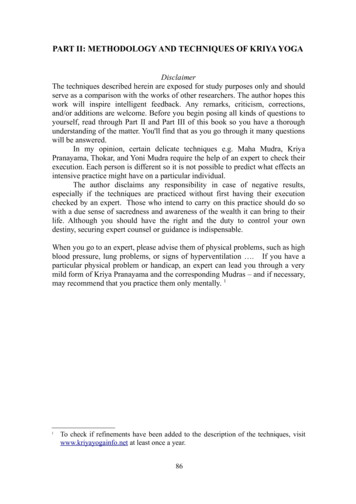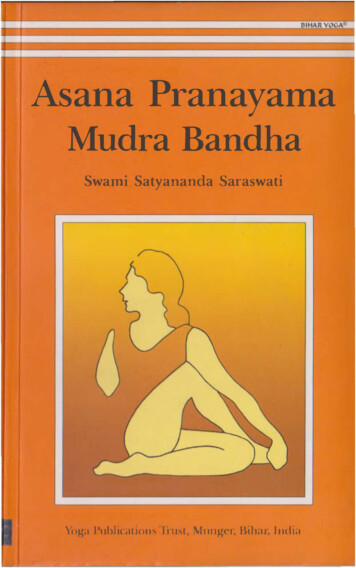
Transcription
Asana PranayamaMudra BandhaSwami Satyananda Saraswati'og.t Pubhcatlons J ntst, Mungct, B1h.u, JndJ.J
Asana PranayamaMudra BandhaWithkind regards,\!aand prem !{, A*-
Asana PranayamaMudra BandhaSwami Satyananda SaraswatiYoga Publications Trust, Munger, Bihar, India
Bihar School of Yoga 1969, 1973, 1996, 2008All rights resetved. No part of this publication may be reproduced,transmitted or stored in a retrieval system, in any form or by anymeans, without permission in writing from Yoga Publications Trust.The terms Satyananda YogaGD and Bihar YogaGD are registered trademarks owned byInternational Yoga Fellowship Movement (IYFM). The use of the same in this bookis with permission and should not in any way be taken as affecting the validity of themarks.Published by Bihar School of YogaFirst edition 1969Reprinted 1971Second edition 1973Reprinted 1977, 1980, 1983, 1989, 1993, 1995, 1996Third (revised) edition 1996 (by Bihar Yoga Bharati withpermission of Bihar School of Yoga)Reprinted 1997, 1999Published by Yoga Publications TrustReprinted 2002, 2004 (twice), 2005, 2006Fourth (revised) edition 2008Reprinted 2008, 2009ISBN: 978-81-86336-14-4Publisher and distributor: Yoga Publications Trust, Ganga Darshan,Munger, Bihar, India.Website: www.biharyoga.netwww .rikhiapeeth.netPrinted at Thomson Press (India) Limited, New Delhi, 110001lV
DedicationIn humility we offer this dedication toSwami Sivananda Saraswati, who initiatedfSwami Satyananda Sarnswati into the secrets o yoga.
ContentsPrefacezx1Introduction to YogaAsanaIntroduction to YogasanaBeginners GroupPawanmuktasana Series1: Anti-rheumatic GroupPart 2: Digestive/Abdominal GroupPart 3: Shakti Bandha AsanasPartYoga Exercises for the EyesRelaxation AsanasMeditation AsanasVajrasana Group of AsanasStanding AsanasSurya NamaskaraChandra NamaskaraIntermediate GroupPadmasana Group of AsanasBackward Bending AsanasForward Bending AsanasSpinal Twisting AsanasInverted AsanasBalancing Asanas919212345607485931 061 371 621 751811 831 9522024325 1285323Advanced naPsychic Physiology of YogaIndex of Practicesvzz
PrefaceThe first edition of Asanain1 969,Pranayama Mudra Bandha, publishedwas derived from the direct teaching of SwamiSatyananda Saraswati during the nine month Teachers Train ing Course conducted at Bihar School of Yoga, Munger, in1 969. The second edition was published in 1 973 to commemo rate his Golden Jubilee. At this time, the text was completelyrevised and new material was added from class notes takenduring the1 970-7 1Sannyasa Training Course, which was thelast course that he personally conducted.In response to popular demand and to meet the require ments of a university text, APMB was revised and updatedunder the direction and inspiration of Swami NiranjananandaSaraswati, the successor of Swami Satyananda Saraswati. Thistext is currently being used as the main practical text for theteaching of asana, pranayama, mudra, bandha and shatkarmaaround the world by yoga teachers from every tradition andpath.Since publication of the first edition, interest in yoga hasspread widely. Now APMB is used in ashrams, centres andyoga schools in every country as the standard textbook forteachers and students alike. The techniques presented havebeen assimilated by fields as diverse as medicine, education,entertainment, business, sports and the training of spiritualaspirants.The science of yoga applies itself to all aspects of life. Thisrevised edition presents basic yogic practices including asanas,postures; pranayamas, breathing techniques;lXmudras,positions
or gestures which represent the psyche;bandhas,locks forchannelling energy; and shatkarmas, cleansing practices. All ofthese techniques purify the body, mind and energy systems toprepare the ground for higher practices of meditation and forthe ultimate experience of cosmic consciousness. Also includedis a section introducing the chakras, psychic centres, and otheraspects of the subtle body.The effects of yogic practices during and after performanceare currently being researched by scientists and doctors aroundthe world. Their results show that asanas, pranayamas, mudrasand bandhas are a potent means to restore and maintainphysical and mental health.Asana Pranayama Mudra Bandhais designed for yogastudents, spiritual seekers and for those studying yoga in depth.Although many health professionals consult this text as a guidewhen constructing programs to provide clients with physical,mental and emotional balance, these techniques are notprimarily for the sick but for the healthy.When learning the practices of yoga, the guidance of acompetent teacher is recommended. People with specific healthproblems or who are undergoing a period when extra care isneeded, such as pregnancy, need individual guidance, nottechniques learned from a book, not even this book. This textprovides yogic practices and information for personal evolution.When practised faithfully, under the guidance of a competentteacher, these techniques will expand your consciousness.X
Introduction to Yoga"Yoga is not an ancient myth buried in oblivion. It is the most valuableinheritance of the present. It is the essential need of today and theculture of tomorrow. "Swami Satyananda SaraswatiYoga is the science of right living and, as such, is intended tobe incorporated in daily life. It works on all aspects of theperson: the physical, vital, mental, emotional, psychic andspiritual.The wordyogameans 'unity' or 'oneness' and is derivedfrom the Sanskrit word yuj, which means 'to join'. This unity orjoining is described in spiritual terms as the union of theindividual consciousness with the universal consciousness. Ona more practical level, yoga is a means of balancing and har monizing the body, mind and emotions. This is done throughthe practice of asana, pranayama, mudra, bandha, shatkarmaand meditation, and must be achieved before union can takeplace with the higher reality.The science of yoga begins to work on the outermost aspectof the personality, the physical body, which for most people isa practical and familiar starting point. When imbalance isexperienced at this level, the organs, muscles and nerves nolonger function in harmony; rather they act in opposition toeach other. For instance, the endocrine system might becomeirregular and the efficiency of the nervous system decrease tosuch an extent that a disease will manifest. Yoga aims at bring ing the different bodily functions into perfect coordination sothat they work for the good of the whole body.1
From the physical body, yoga moves on to the mental andemotional levels. Many people suffer from phobias and neurosesas a result of the stresses and interactions of everyday living.Yoga cannot provide a cure for life, but it does present aproven method for coping with it.Swami Sivananda Saraswati of Rishikesh explained yoga asan ". . . integration and harmony between thought, feeling anddeed, or integration between head, heart and hand". Throughthe practices of yoga, awareness develops of the interrelationbetween the emotional, mental and physical levels, and how adisturbance in any one of these affects the others. Gradually,this awareness leads to an understanding of the more subtleareas of existence.There are many branches of yoga: raja, hatha, jnana, karma,bhakti, mantra, kundalini and laya, to name but a few, andmany texts explain them in detail. Each individual needs tofind those yogas most suited to his/her particular personalityand need. In the last half of the twentieth century, hatha yogahad become the most well known and widely practised of thesystems. However, the concept of what constitutes yoga isbroadening as more people take it up, and this knowledge isspreading. In the ancient texts, hatha yoga consists of theshatkarmas, cleansing practices, only. Today, however, hathayoga commonly embraces the practices of asana, pranayama,mudra and bandha as well.History of yogaThe yoga we know today was developed as a part of the tantriccivilization which existed in India and all parts of the world morethan ten thousand years ago. In archaeological excavations madein the Indus Valley at Harappa and Mohenjodaro, now in mod em Pakistan, many statues have been found depicting deitiesresembling Lord Shiva and Shakti (in the form of Parvati) per forming various asanas and practising meditation. These ruinswere once the dwelling place of people who lived in the pre-vedicage before the Aryan civilization started to flourish in the Indussubcontinent. According to mythical tradition, Shiva is said to bethe founder of yoga and Parvati, his first disciple.2
Lord Shiva is considered to be the symbol or embodiment ofsupreme consciousness. Parvati represents supreme knowledge,will and action, and is responsible for all creation. This force orenergy is also known as kundalini shakti, the cosmic force whichlies dormant in all beings. Parvati is regarded as the mother ofthe whole universe. The individual soul is embodied and boundto the world of name and form, and also liberated from thebondage of the world and united with supreme consciousnessthrough her grace. Out of love and compassion for her children,she imparted her secret knowledge of liberation in the form oftantra. The techniques of yoga have their source in tantra and thetwo cannot be separated, just as consciousness, Shiva, cannot beseparated from energy, Shakti.Tantra is a combination of two words, tanoti and trayati,which mean 'expansion' and 'liberation' respectively. There fore, it is the science of expanding the consciousness andliberating the energy. Tantra is the way to attain freedom from .the bondage of the world while still living in it. The first step intantra is to know the limitations and capacities of the body andmind. Next it prescribes techniques for the expansion of con sciousness and the liberation of energy whereby individuallimitations are transcended and a higher reality experienced.Yoga arose at the beginning of human civilization whenhumankind first realized their spiritual potential and began toevolve techniques to develop it. The yogic science was slowlydeveloped by ancient sages all over the world. The essence ofyoga has often been shrouded in or explained by different symbols,analogies and languages. Some traditions believe that yoga was adivine gift revealed to the ancient sages so that humankind couldhave the opportunity to realize its divine nature.In ancient times, yoga techniques were kept secret andwere never written down or exposed to public view. They werepassed on from teacher or guru to disciple by word of mouth.In this way there was a clear understanding of their meaningand aim. Through personal experience, realized yogis andsages were able to guide sincere aspirants along the correctpath, removing any confusion, misunderstanding and exces sive intellectual contemplation.3
The first books to refer to yoga were the ancient Tantrasand later the Vedas, which were written about the time theIndus Valley culture was flourishing. Although they do notgive specific practices, they allude to yoga symbolically. In fact,the verses of the Vedas were heard by the rishis, seers, in statesof deep yogic meditation or samadhi, and are regarded asrevealed scriptures. It is, however, in the Upanishads that yogabegins to take a more definable shape. These scriptures collec tively form Vedanta, the culmination of the Vedas, and are saidto contain the essence of the Vedas.Sage Patanjali's treatise on raja yoga, the Yoga Sutras, codi fied the first definitive, unified and comprehensive system ofyoga. Often called the eight-fold path, it is comprised of yama,self-restraints, niyama, self-observances, asana, pranayama,pratyahara, disassociation of consciousness from the outsideenvironment, dharana, concentration, dhyana, meditation, andsamadhi, identification with pure consciousness.In the 6th century BC, Buddha's influence brought theideals of meditation, ethics and morality to the fore and thepreparatory practices of yoga were ignored. However, Indianthinkers soon realized the limitations of this view. The yogiMatsyendranath taught that before taking to the practices ofmeditation, the body and its elements need purifying. Hefounded the N ath cult and the yogic pose matsyendrasana wasnamed after him. His chief disciple, Gorakhnath, wrote bookson hatha yoga in the local dialect and in Hindi.Indian tradition previously required that original texts bewritten in Sanskrit. In some cases they clothed their writings insymbolism so that only those qualified to receive a teachingwould be able to understand it. One of the most outstandingauthorities on hatha yoga, Swami Swatmarama, wrote the HathaYoga Pradipika, or 'Light on Yoga', in Sanskrit, collating allextant material on the subject. In doing so, he reduced theemphasis on yama and niyama, thereby eliminating a greatobstacle experienced by many beginners. In the Hatha YogaPradipika, Swatmarama starts with the body and only later,when the mind has become stable and balanced, are the yamasand niyamas (self-control and self-discipline) introduced.4
The relevance of yoga todayToday, in the 21st century, a spiritual heritage is being re claimed of which yoga is very much a part. While yoga's centraltheme remains the highest goal of the spiritual path, yogicpractices give direct and tangible benefits to everyone regard less of their spiritual aims.Physical and mental cleansing and strengthening is one ofyoga's most important achievements. What makes it so powerfuland effective is the fact that it works on the holistic principlesof harmony and unification. According to medical scientists,yoga therapy is successful because of the balance created in thenervous and endocrine systems which directly influences allthe other systems and organs of the body.For most people in the 20th century, yoga was simply ameans of maintaining health and well-being in an increas ingly stressful society. Asanas do remove the physical discomfortaccumulated during a day at the office sitting in a chair,hunched over a desk. Relaxation techniques help to maximizethe effectiveness of ever-diminishing time off. In an age ofmobile phones, beepers and twenty-four hour shopping, yogicpractices make great personal and even business sense.In the 21st century, beyond the needs of individuals, theunderlying principles of yoga provide a real tool to combatsocial malaise. At a time when the world seems to be at a loss,rejecting past values without being able to establish new ones,yoga provides a means for people to find their own way ofconnecting with their true selves. Through this connection withtheir real selves, it is possible for people to manifest harmony inthe current age, and for compassion to emerge where hithertothere has been none.In this respect, yoga is far from simply being physicalexercises. It is an aid to establishing a new perception of whatis real, what is necessary, and how to become established in away of life which embraces both inner and outer realities. Thisway of life is an experience which cannot be understood intel lectually and will only become living knowledge throughpractice and experience. However, the renaissance hasbegun.5
.jJjjjjjjjjjjjjjjjjjjjjjjjjjjjjjjjjjjjjjj
As ana
sae qi41(CIIa: e4 l{ci a 1C§4fi1C{Ie;:j t44qlfjH;j 'Cii4l IQCi'(ll : \911 H athasya prathamaangatvaadaasanam pooroamuchyate.Kuryaattadaasanam sthairyamaarogyam chaangalaaghavam.Prior to everything, asana is spoken ofasthe first part ofhatha yoga.Having done asana, one attains steadiness of body and mind,freedom from disease and lightness of the limbs.Hatha Yoga Pradipika (1: 17)Asana means a state of being in which one can remain physicallyand mentally steady, calm, quiet and comfortable. In the Yoga Sutrasof Patanjali there is a concise definition of yogasanas: "Sthiramsukham aasanam", meaning that position which is comfortable andsteady. So, we can see that yogasanas in this context are practised todevelop the practitioner's ability to sit comfortably in one positionfor an extended length of time, as is necessary during meditation.In raja yoga, asana refers to the sitting position, but in hathayoga it means something more. Asanas are specific body positionswhich open the energy channels and psychic centres. They are toolsto higher awareness and provide the stable foundation for ourexploration of the body, breath, mind and beyond. The hatha yogisalso found that by developing control of the body through asana,the mind is also controlled. Therefore, the practice of asana isforemost in hatha yoga.
Introduction to Yogasanan the Yoga Sutras of Pata11jali there is a concise definition ofyogasana: "Sthiram sukham aasanam ", meaning 'that positionwhich is con1fortable and steady'. In this context, asanas arepractised to develop the ability to sit comfortably in one positionfor an extended period of time, an ability necessary formeditation. Raja yoga equates yogasana to the stable sittingposition.The hatha yogis, however, found that certain specific bodypositions, asanas, open the energy channels and psychic centres.They found that developing control of the body through thesepractices enabled them to control the mind and energy.Yogasanas became tools to higher awareness, providing thestable foundation necessary for the exploration of the body,breath, mind and higher states. For this reason, asana practicecomes first in hatha yoga texts such as Hatha Yoga Pradipika.In the yogic scriptures it is said that there were originally8,400,000 asanas, which represent the 8,400,000 incarnationsevery individual tnust pass through before attaining liberationfrom the cycle of birth and death. These asanas represented aprogressive evolution from the simplest form of life to themost complex: that of a fully realized human being. Downthrough the ages the great rishis and yogis modified andreduced the number of asanas to the few hundred knowntoday. Of these few hundred, only the eighty-four most usefulare discussed in detail. Through their practice, it is possible toside-step the karmic process and bypass many evolutionarystages in one lifetime.I9
Animal posturesMany of the yogasanas described in this book are named afterand reflect the movements of ani1nals. Through observation,the rishis understood how animals live in harmony with theirenvironment and with their own bodies. They understood,through experience, the effects of a particular posture andhow the hormonal secretions could be stimulated and control led by it. For example, by imitating the rabbit or hare inshashankasana they could influence the flow of adrenalineresponsible for the 'fight or flight' mechanism. Through inli tating animal postures, the rishis found they could Inaintainhealth and meet the challenges of nature for themselves.Yogasanas and pranaPrana, vital energy, which coiTesponds to ki or chi in Chinesemedicine, pervades the whole body, following flow patterns,called nadis, which are responsible for maintaining all individualcellular activity. Stiffness of the body is due to blocked pranaand a subsequent accumulation of toxins. When prana beginsto flow, the toxins are removed from the system, ensuring thehealth of the whole body. As the body becomes supple, postureswhich seemed impossible become easy to perform, andsteadiness and grace ofmoven1ent develop. When the quantumof prana is increased to a great degree, the body moves intocertain postures by itself and asanas, mudras and pranayamasoccur spontaneously.Yogasanas and kundaliniThe ultimate purpose of yoga is the awakening of kundalinishakti, the evolutionary energy in man. Practising asanas stimu lates the chakras, distributing the generated energy ofkundalini all over the body. About thirty-five asanas are spe cifically geared to this purpose: chakrasana for manipurachakra, sarvangasana for vishuddhi, sirshasana for sahasraraand so on. The other asanas regulate and purify the nadis,facilitating the conduction of prana throughout the body. Themain object of hatha yoga is to create balance between theinteracting activities and processes of the pranic and mental10
forces. Once this has been achieved, the impulses generatedgive a call of awakening to sushumna nadi, the central pathwayin the spine, through which the kundalini energy ascends tosahasrara chakra, thereby illumining the higher centres ofhuman consciousness.Hatha yoga, therefore, not only strengthens the body andimproves health, but also activates and awakens the higher cen tres responsible for the evolution of human consciousness.Yogasanas and the body-mind connectionThe mind and body are not separate entities, although there isa tendency to think and act as though they are. The gross formof the mind is the body and the subtle form of the body is themind. The practice of asana integrates and harmonizes thetwo. Both the body, and the mind harbour tensions or knots.Every mental knot has a corresponding physical, muscularknot and vice versa.The aim of asana is to release these knots. Asanas releasemental tensions by dealing with them on the physical level,acting somato-psychically, through the body to the mind. Forexample, emotional tensions and suppression can tighten upand block the smooth functioning of the lungs, diaphragmand breathing process, contributing to debilitating illnesses inthe form of respiratory disorders.Muscular knots can occur anywhere in the body: tightnessof the neck as cervical spondylitis, the face as neuralgia, etc. Awell chosen set of asanas, combined with pranayama,shatkarmas, meditation and yoga nidra, is most effective ineliminating these knots, tackling them from both the mentaland physical levels. The result is the release of dormant en ergy; the body becomes full of vitality and strength, and themind becomes light, creative, joyful and balanced.Regular practice of asana maintains the physical body in anoptimum condition and promotes health even in an unhealthybody. Through asana practice, the dormant energy potentialis released and experienced as increased confidence in allareas of life.11
Yogasana and exerciseYogasanas have often been thought of as a form of exercise.They are not exercises, but techniques which place the physi cal body in positions that cultivate awareness, relaxation,concentration and meditation. Part of this process is thedevelopment of good physical health by stretching, massagingand stimulating the pranic channels and internal organs, soasana is complementary to exercise. Before the differencebetween the two can be understood, it is necessary to know thatexercise imposes a beneficial stress on the body. Without it themuscles waste, the bones become weak, the capacity to absorboxygen decreases, insulin insensitivity can occur, and the abilityto meet the physical demands of sudden activity is lost.There are several differences in the way asana and exerciseaffect body mechanisms. When yogasanas are performed, res piration and metabolic rates slow down, the consumption ofoxygen and the body temperature drop. During exercise,however, the breath and metabolism speed up, oxygen con sumption rises, and the body gets hot. Yoga postures tend toarrest catabolism whereas exercise promotes it. In addition,asanas are designed to have specific effects on the glands andinternal organs, and to alter electrochemical activity in thenervous system.Yogasanas classifiedThe asanas are classified into three groups: beginners, inter mediate and advanced. It is not necessary to perform all theasanas in a particular group. Regular practice of a balancedprogram, tailored to individual needs, is recommended formaximum benefit.The beginners group should be performed by those whohave never practised yogasanas before. Only a selection fromthis group, tailored to individual needs, should be practisedby those who are infirm in any way, weak or sick. They willgive greater benefits than more difficult practices. This groupconsists of elementary techniques designed to prepare thebody and n1ind for major and meditation asanas. Thesepractices are in no way inferior to the advanced asanas and12
are very useful in improving physical health. Experiencedpractitioners in particular will notice the profound yet subtlebalancing effect. Included in this group are thepawanmuktasana series, eye exercises, relaxation, pre meditation and meditation poses, asanas performed fromvajrasana, standing asanas, surya and chandra namaskara.The intermediate group consists of asanas which are reason ably difficult and are recommended for people who can performthe beginners group without discomfort or strain. These asanasrequire a greater degree of steadiness, concentration and coor dination with the breath. Included in this group are asanasperformed from padmasana, backward and fmward bending,spinal twisting, inverted and balancing asanas.The advanced group is intended for people with extensivecontrol over their muscles and nervous system, who have alreadymastered the middle group of asanas. Practitioners should notbe too eager to start these asanas. It is preferable to practisethem under the guidance of a competent teacher.Dynamic and static yogasanasDynamic practices often involve energetic moven1ents of thebody. They are intended to increase flexibility, improvecirculation, tone the muscles and joints, release energy blocksand remove stagnant waste from different parts of the body.These asanas strengthen the lungs and improve the digestiveand excretory systems. Dynamic practices are particularly usefulfor beginners. They include the pawanmuktasana series, suryanamaskara, chandra namaskara, dynamic paschimottanasanaand dynamic halasana.Static practices of intermediate and advanced asanas areperformed by experienced practitioners. They have a moresubtle and powerful effect on the pranic and mental bodies.They are performed with little or no movement, the bodyoften remaining in one position for a few minutes. Theseasanas are intended to gently massage the internal organs,glands and muscles as well as to relax the nerves throughoutthe body. They are specifically concerned with bringingtranquillity to the mind and preparing the practitioner for the13
higher practices of yoga, such as meditation. Some of themare particularly useful for inducing the state of sensewithdrawal, pratyahara.General notes for the practitionerThe following practice notes should be thoroughly under stood before going any further. Although anybody canpractise asanas, they become more efficacious and benefi cial when performed in the proper manner after correctpreparation.Breathing: Always breathe through the nose unless specificinstructions are given to the contrary. Coordinate the breathwith the asana practice.Awareness: This is as essential to the practice of asana as itis to all yoga practices. The purpose of asana practice is toinfluence, integrate and harmonize all the levels of being:physical, pranic, mental, emotional, psychic and spiritual. Atfirst it may appear that asanas are merely concerned with thephysical level because they deal with the movement of differentparts of the body, but they have profound effects at every levelof being if they are combined with awareness.Awareness in this context may be understood as consciouslynoting sensations in the body, the physical movement, theposture itself, breath control and synchronization, movementof prana, concentration on an area of the body or chakra and,most importantly, witnessing any thoughts or feelings thatmay arise during the practice. Implicit in the concept of aware ness is the acceptance of any thought or feeling which comesuninvited to the mind. This awareness is essential in order toreceive optimum benefits from the practices.Right or left side: An example of the necessity for con tinual awareness is that most right-handed people will find iteasier to commence an asana on the right side, which is moredeveloped due to habitual patterns of behaviour. Once theasana is learned, however, it is better to lead with the left sideand promote its development.Relaxation: Shavasana may be performed at any point dur ing asana practice, especially when feeling physically or14
mentally tired. It should also be practised on completion ofthe asana program.Sequence: After completing shatkarma, asana should bedone, followed by pranayama, then pratyahara and dharanawhich lead to meditation.Counterpose: When practising the middle and advancedgroup of asanas particularly, it is important that the programis structured so that backward bends are followed by forwardbends and vice versa, and that whatever is practised on oneside of the body is repeated on the other side. This concept ofcounterpose is necessary to bring the body back to a balancedstate. Specific counterposes are recommended for certain asanasdescribed in this book.Time of practice: Asanas may be practised at any time of dayexcept after meals. The best time, however, is the two hoursbefore and including sunrise. This period of the day is known inSanskrit as bralmwmuhurta, the most conducive time for higheryogic practices, when the atmosphere is pure and quiet, theactivities of the stomach and intestines have stopped, the mindhas no deep impressions on the conscious level and is empty ofthoughts in preparation for the day ahead. The practitioner willprobably find that the muscles are stiffest early in the morningcompared to the late afternoon when they become more supple.Nevertheless this time is recommended for practice. In theevening the two hours around sunset is also a favourable time.Pregnancy: Many asanas are helpful during pregnancy,but it is important to check with a midwife/doctor/competentyoga teacher prior to practising. Do not strain. Do not useinverted asanas in the later stages of pregnancy.Age limitations: Asanas may be practised by people of allage groups, male and female.Place
Tantra is a combination of two words, tanoti and trayati, which mean 'expansion' and 'liberation' respectively. There fore, it is the science of expanding the consciousness and liberating the energy. Tantra
